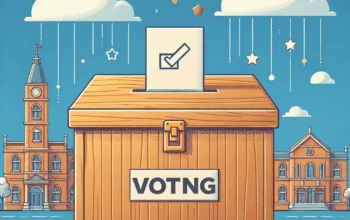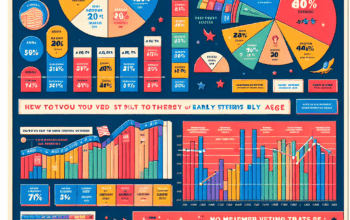Voter Turnout Insights: What the Numbers Are Telling Us
The 2025 elections have reignited discussions on voter turnout, bringing important insights into the motivations, barriers, and demographics that influence electoral participation. Understanding these factors not only deepens our knowledge of the political landscape but also helps devise strategies to enhance voter engagement. Analyzing data from recent elections illuminates trends and offers a glimpse into the future of democracy. This article delves into voter turnout insights, presenting the numbers and their implications for the political climate in 2025.
Understanding Voter Turnout Trends in 2025
Voter turnout is a critical indicator of civic engagement and public interest in the democratic process. In 2025, the statistics reveal a complex narrative about who is voting and why. For instance, data indicates that voter turnout among young voters aged 18-29 has seen a notable increase, with approximately 58% participating in the 2024 elections, up from the previous 50% in 2020. This surge can be attributed to heightened political awareness surrounding issues such as climate change, social justice, and economic inequality. Young voters are increasingly mobilizing through social media and grassroots movements, emphasizing their desire for representation in government.
In contrast, turnout among older demographics, particularly those aged 65 and above, has remained stable at around 75%. This consistent participation reflects their longstanding civic engagement but also raises questions about the effectiveness of outreach efforts targeting younger generations to maintain and elevate their participation levels. Understanding these trends is essential for political candidates and organizations looking to tailor their messages and strategies to maximize voter turnout across age groups.
The Impact of Technology on Voter Engagement
The technological landscape has dramatically altered how voters engage with the electoral process. In 2025, digital platforms have become pivotal in facilitating voter registration, providing information about candidates, and mobilizing voters. According to recent surveys, 71% of voters used online resources to research candidates and issues during the last election cycle. This indicates a significant shift from traditional methods of information gathering, highlighting the importance of a robust digital presence for candidates and political parties.
Moreover, mobile applications and social media campaigns have proven effective in reminding individuals to vote, with reminders generated through these platforms reaching over 30 million voters leading up to Election Day. The role of technology transcends mere information dissemination; it has transformed how voters perceive their influence in the political process. Digital outreach initiatives have empowered underrepresented groups, including minorities and young voters, providing them with tools to express their opinions and coordinate collective actions. Embracing technology responsibly remains crucial for future elections.
Barriers to Voter Participation: A Closer Look
Despite positive trends in voter turnout, significant barriers remain, hindering many from participating in elections. One of the most pronounced obstacles is voter ID laws, which have been enacted in several states. Recent studies indicate that approximately 8% of eligible voters, particularly those from minority and low-income backgrounds, lack the required identification to cast their votes. These laws disproportionately affect those in vulnerable communities, creating systemic inequities in electoral participation.
Another substantial barrier includes accessibility issues related to polling places. In the 2024 elections, reports revealed that several polling stations were inadequately equipped for individuals with disabilities, resulting in disenfranchisement for thousands. Local governments must prioritize making voting locations more accessible, ensuring that all citizens can exercise their democratic rights without hindrance. Addressing these barriers through legislation and community outreach is vital to fostering a more inclusive electoral process.
Additionally, misconceptions about the voting process can deter eligible voters. Misinformation regarding registration deadlines, mail-in voting procedures, and polling hours has proliferated, especially on social media. Educational initiatives aimed at clarifying the voting process can mitigate this issue, ensuring that voters are well-informed and feel confident about their ability to participate.
Demographic Shifts and Their Influence on Voter Turnout
The demographic landscape in the United States continues to evolve, significantly impacting voter turnout trends in 2025. Recent census data reveal that minority populations, particularly Hispanic and Asian American voters, have shown an uptick in participation. In the last election, Hispanic voter turnout reached 50%, a notable increase compared to previous years, driven by targeted campaigns that address issues pertinent to these communities, such as immigration reform and healthcare access.
The increasing diversity of the electorate necessitates that candidates recognize and respect the varied experiences and issues that resonate with different groups. Failure to engage effectively with diverse demographics may result in missed opportunities to galvanize voter support. Furthermore, as urban areas continue to expand and attract younger, more diverse populations, we can expect shifts in political power dynamics. Candidates who adapt their messaging to cater to a broader audience are likely to see improved voter turnout in these populations.
The impact of education on voter turnout cannot be overlooked either. Higher levels of educational attainment correlate with increased participation in elections. In 2025, individuals with college degrees voted at a rate of approximately 82%, significantly higher than those with only a high school diploma, who participated at a rate of 50%. This trend emphasizes the need for initiatives that target educational systems, fostering a culture of civic engagement from a young age.
Strategies to Enhance Voter Engagement and Turnout
To address the nuanced challenges faced in improving voter turnout, multifaceted strategies must be developed and implemented. One effective approach is to enhance grassroots movements that mobilize communities. Organizations dedicated to increasing voter participation have proven successful in reaching underrepresented demographics through door-to-door campaigns, community events, and local partnerships. These initiatives often foster a deeper sense of community and collective responsibility, encouraging individuals to vote as an act of civic pride.
Educational campaigns focused on demystifying the voting process also play a crucial role in enhancing turnout. By partnering with schools, universities, and community organizations, these campaigns can provide necessary information about registration and voting procedures, especially to first-time voters. Engaging storytelling and testimonials can help humanize the voting experience, inspiring reluctant individuals to participate in shaping their collective future.
Finally, collaboration between political entities and technology firms can yield innovative solutions that streamline the voting process. Initiatives such as automated voter registration or user-friendly online portals for accessing voting information can significantly reduce barriers to participation. Additionally, investing in secure and accessible electronic voting systems could help accommodate the changing landscape of democratic engagement for future elections.
Conclusion
Voter turnout insights from the recent elections reflect a dynamic landscape driven by a multitude of factors. While we see encouraging trends among young and diverse voters, significant challenges remain in addressing barriers to participation. The role of technology in mobilizing voters and providing vital information is more important than ever. Additionally, the demographic shifts within the electorate necessitate a more nuanced and inclusive approach to political engagement. By implementing comprehensive strategies that address systemic obstacles and enhance voter education, we can aspire to foster a more engaged and participatory democracy.
FAQs
What are the main factors influencing voter turnout?
Several factors influence voter turnout, including age, education level, socio-economic status, and access to voting resources. Technology and social movements also play a crucial role in mobilizing voters, especially among younger demographics.
How does voter ID legislation impact turnout?
Voter ID laws can significantly impact turnout by disproportionately affecting underrepresented groups who may lack the required identification. Research shows that such laws can disenfranchise eligible voters, hindering their participation in elections.
What strategies can improve voter turnout?
Successful strategies to improve voter turnout include grassroots mobilization, educational campaigns that clarify the voting process, and leveraging technology to enhance access to registration and voting information. Collaboration between local governments and community organizations is essential for fostering inclusive participation.












